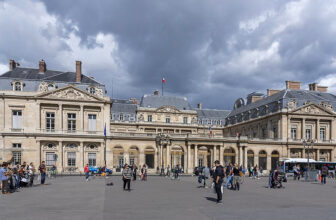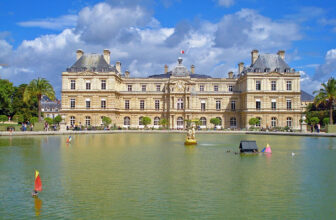
Is Grand Trianon worth seeing?
A Journey Through Time and Elegance
Nestled within the sprawling gardens of the Palace of Versailles, the Grand Trianon is one of France’s most exquisite yet often overlooked architectural gems. With its elegant pink marble columns, sprawling formal gardens, and a history steeped in the grandeur of French royalty, this palace offers an intimate glimpse into the lives of some of history’s most fascinating figures. But is it worth visiting? To answer that question, let’s explore what makes the Grand Trianon famous, what’s inside, and why it deserves a spot on your travel itinerary.
What is the Grand Trianon Paris Famous For?

Is Trianon worth visiting
The Grand Trianon is famous for its refined elegance, royal history, and breathtaking architecture. Built in 1687 by order of King Louis XIV, it was designed by architect Jules Hardouin-Mansart as a private retreat where the king could escape the rigid formality of life at Versailles. Unlike the opulent grandeur of the main palace, the Grand Trianon offers a more intimate, refined beauty that reflects the Sun King’s desire for a peaceful sanctuary.
One of its defining features is the use of pink Languedoc marble, which gives the structure its distinct and delicate hue. The blend of Italian and French architectural styles creates a light, airy feel, making it one of the most enchanting palaces in France. The Grand Trianon served as a refuge for not only Louis XIV and his mistresses but also later French rulers, including Napoleon Bonaparte, who used it as a summer residence.
During the 19th century, the Grand Trianon continued to play a role in French history. Napoleon had it restored for his empress, Marie-Louise of Austria, and it later became a favored retreat of King Louis-Philippe. Even in the 20th century, the Grand Trianon was significant, hosting diplomatic meetings, including the signing of the Trianon Treaty in 1920, which redrew borders after World War I.
What’s Inside the Grand Trianon?
Inside, the Grand Trianon is a stunning showcase of classical French design, period furniture, and exquisite artwork. Unlike the grandeur of the main Versailles palace, the Grand Trianon offers a more tranquil, elegant atmosphere that feels almost personal.
The Grand Apartments
The Grand Apartments are a highlight of the visit, featuring lavishly decorated rooms that once hosted kings, queens, and emperors. These rooms maintain their historical charm, adorned with intricate gilded moldings, opulent draperies, and exquisite furnishings.
- The Mirror Room (Salon des Glaces): This stunning room, lined with large mirrors reflecting the surrounding gardens, was used for entertaining and receptions. Unlike the Hall of Mirrors in Versailles, it has a more intimate and refined beauty.
- The Empress’s Bedroom: A beautiful and lavishly decorated room, this space was designed for Napoleon’s wife, Empress Marie-Louise. It features ornate tapestries, a grand four-poster bed, and luxurious decor reflecting the Empire style.
- The Cotelle Gallery: This long gallery, named after the artist Jean Cotelle, features a series of paintings depicting the gardens of Versailles and Trianon as they appeared in the late 17th century. The gallery’s light-filled ambiance and elegant decor make it a serene place to explore.
The Peristyle and Marble Courtyard
One of the Grand Trianon’s most famous features is its peristyle—a long, open colonnade of pink marble columns that connect the two wings of the palace. This architectural marvel offers breathtaking views of the surrounding gardens and is a masterpiece of symmetry and harmony. The adjacent Marble Courtyard enhances the sense of openness, creating an airy, dreamlike atmosphere.
The Grand Trianon Gardens
The gardens of the Grand Trianon are a true highlight. Designed in the formal French style, they feature geometric flower beds, perfectly manicured lawns, and elegant fountains. Unlike the overwhelming scale of the gardens at Versailles, the Grand Trianon’s gardens feel more intimate and walkable, offering a peaceful retreat from the grandeur of the main palace.
- The Flower Parterre: This beautifully arranged garden area is full of vibrant blooms in the spring and summer, providing a stunning contrast against the pink marble of the palace.
- The Grand Canal Views: While smaller than the main Grand Canal at Versailles, the reflective pools and serene waterscapes of the Grand Trianon gardens create a tranquil escape.
- The Bosquets and Hidden Walkways: These shaded groves and secret pathways offer a charming place to stroll, with surprises at every turn, from ornate fountains to sculpted hedges.
Is It Worth Visiting the Grand Trianon?
Absolutely. If you’re already visiting Versailles, the Grand Trianon is a must-see for anyone who appreciates history, architecture, and peaceful beauty. Here’s why it’s worth your time:
1. A More Intimate Experience Than Versailles
The Palace of Versailles is a breathtaking, must-visit destination, but it can also be overwhelming due to its sheer size and the large crowds it attracts. The Grand Trianon, in contrast, offers a quieter, more intimate experience where you can truly appreciate the craftsmanship and elegance of 17th-century French architecture without the bustling crowds.
2. A Unique Blend of History and Architecture
Unlike the grandiosity of Versailles, the Grand Trianon reflects a different side of French royalty—one of relaxation, personal taste, and refined luxury. It provides an insightful contrast to the main palace and showcases Louis XIV’s vision beyond just opulence.
3. The Gardens Are a Hidden Gem
While Versailles’ gardens are iconic, the gardens of the Grand Trianon are a delightful, lesser-known treasure. They offer a more peaceful experience, allowing visitors to wander without the same level of congestion. The floral arrangements, fountains, and carefully maintained greenery provide a perfect setting for a leisurely afternoon.
4. A Connection to Napoleon’s Legacy
For those interested in Napoleon, the Grand Trianon holds special significance. Seeing the rooms used by the emperor and his wife gives a tangible connection to one of history’s most fascinating figures, making it a must-visit for history buffs.
5. A Romantic and Photogenic Destination
If you love photography or are looking for a romantic setting, the Grand Trianon’s pastel-hued marble, elegant columns, and lush gardens provide countless picture-perfect moments. It’s a dream location for those who appreciate beauty and aesthetics.
Tips for Visiting the Grand Trianon
- Buy a Combined Ticket: Access to the Grand Trianon is included in the Versailles Passport ticket, which allows entry to the entire Versailles estate.
- Visit in the Morning or Late Afternoon: To avoid crowds, plan to visit early or later in the day when most visitors are at the main palace.
- Wear Comfortable Shoes: While the Grand Trianon itself isn’t massive, the gardens and surrounding estate involve a lot of walking.
- Pair It with the Petit Trianon: Nearby, you’ll find the Petit Trianon, Marie Antoinette’s private retreat, which offers another layer of fascinating history and beauty.
A Hidden Treasure Worth Exploring
If you’re looking for a serene, historically rich, and visually stunning escape within Versailles, the Grand Trianon is absolutely worth a visit. It offers a rare glimpse into the personal world of French royalty, away from the grandeur of the main palace. Whether you’re a history enthusiast, an architecture lover, or simply someone who enjoys beautiful places, the Grand Trianon is a jewel that deserves to be discovered.
So, on your next trip to Paris, make sure to venture beyond the Hall of Mirrors and step into the refined elegance of the Grand Trianon. You won’t regret it. image/wikimedia





